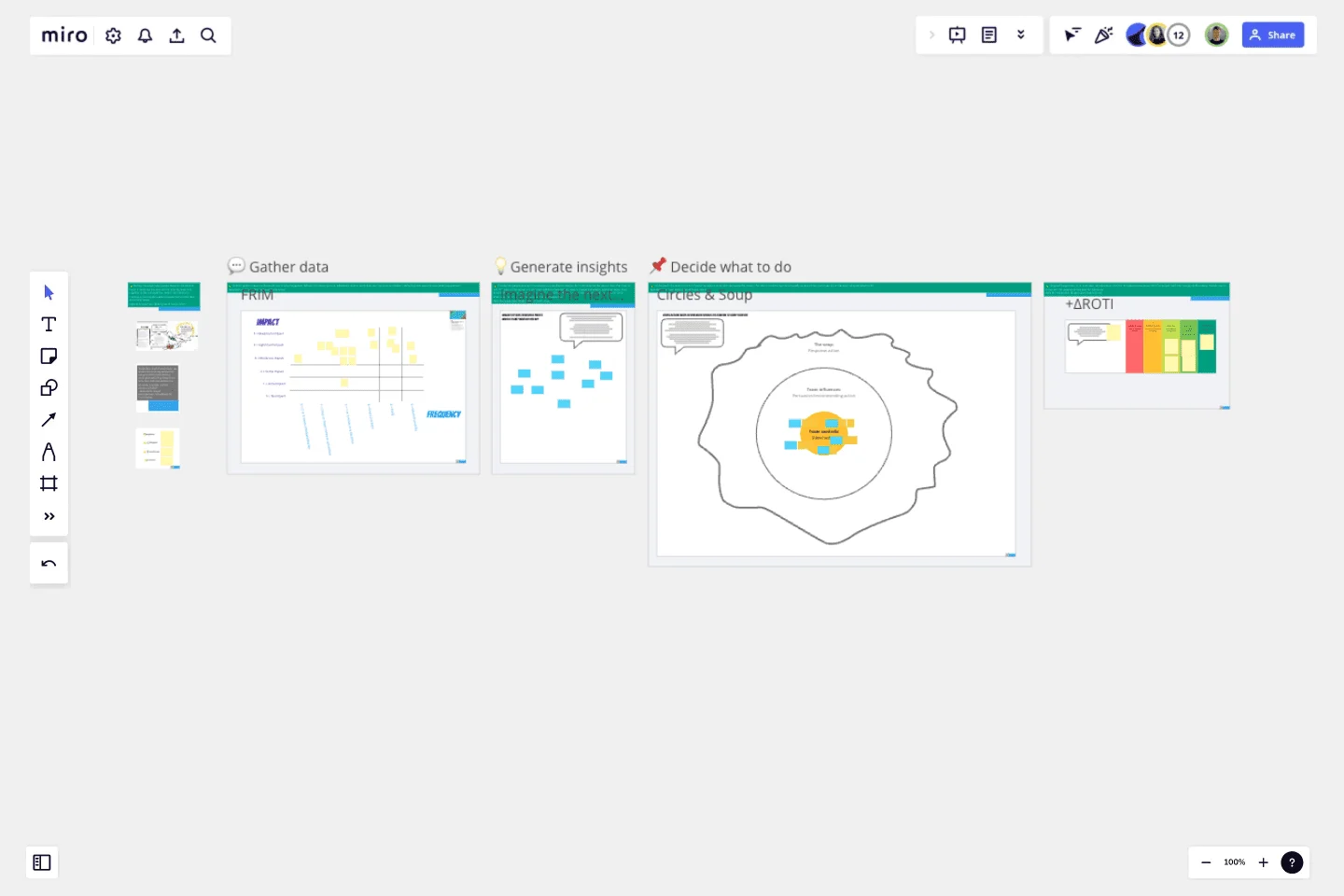Agile Retrospective
Gather and organize ideas with this retro!
This template offers scaffolding frames for the 5 steps of an Agile Retrospective to follow a structure that helps focusing the group on the work at hand, getting a shared perspective, fostering divergent thinking, coming up with actionable ideas and closing with a sense of having achieved something.
When to use this template?
You should try it if you your “retrospectives” are feeling ineffective and you have a feeling nothing ever changes, other challenges it helps with:
When you have room full of disengaged individuals
When your actions land on premature convergence and habitual thinking
Or there are no actions at all
Each frame has a set of activities that would fit a team of 5 or 6 looking at a 10/15 days time span. You should change activities if you think they don’t fit in your context.
How does a five steps Agile Retrospective work?
As a tech lead, scrum master or product manager you are challenged with running effective retrospectives. This template will guide you to focus on:
Setting the stage to be present and energized in a blame free mindset.
Clarify roles. Could it be useful to have somebody taking notes while you focus on facilitation? How about a timekeeper?
Is there any team agreement we need to highlight. The OARRs is the place!
You can then read Kerth’s prime directive from the template. Then you can do a voting on the ESVP (Explorer, Shopper, Vacationer, Prisoner). If everybody is a prisoner would it be beneficial to focus on why that is rather than going ahead with your plan?
Gather data to pause and collect all perspectives about the topic. The FRIM activity in the template uses axis with Frequency and Impact for the events we share.
Generate insights, divergent thinking about how the next iteration can be the best one yet?
Decide what to do to browse the ideas that emerged during generate insights and decide which ones we want to tackle in the next iteration. The template activity circles and soups allows to visualize what the team can control and the rest.
Close out to get feedback on the retrospective. In the template use ROTIPlusDelta to determine how the retrospective went and collect one change that would have increased your return on time invested and one thing you liked about the session.
If you’re used to the 3 column approach I wrote a blog post discussing pro and challenges of moving away from that.
The Agile Retrospective template is a Miro representation of an Agile Retrospective as intended by its creators in the seminal book “Agile Retrospectives Making good teams great” by Esther Derby and Diana Larsen. All activities are credited in the template itself.
Get started with this template right now.
Quick Retrospective Template
Works best for:
Education, Retrospectives, Meetings
A retrospective template empowers you to run insightful meetings, take stock of your work, and iterate effectively. The term “retrospective” has gained popularity over the more common “debriefing” and “post-mortem,” since it’s more value-neutral than the other terms. Some teams refer to these meetings as “sprint retrospectives” or “iteration retrospectives,” “agile retrospectives” or “iteration retrospectives.” Whether you are a scrum team, using the agile methodology, or doing a specific type of retrospective (e.g. a mad, sad, glad retrospective), the goals are generally the same: discovering what went well, identifying the root cause of problems you had, and finding ways to do better in the next iteration.
Target Audience Template
Works best for:
Marketing, Desk Research, Prioritization
Understanding your target audience is vital to business success. How can you market yourself effectively if you don’t know who you’re targeting? Using the Target Audience template, you can review valuable data about who your customers are and what they want from your product or service.
Infographic Template
Works best for:
Marketing, Desk Research, Documentation
As we bet you’ve experienced, data can get pretty dense and dry. But you need it to be compelling, memorable, and understandable. The solution? Infographics. These are tools that let you present information in a visually striking way and turn quantitative or qualitative data into stories that engage and resonate. Whoever you’ll be presenting to — customers, donors, or your own internal teams — our template will let you design an infographic that combines text and visuals to break down even the most complicated data.
5W2H Template
Works best for:
Project Management
The 5W2H template is a tool used in project management and analysis to break down information systematically. By addressing the who, what, when, where, why, how, and how aspects of the issue, the template ensures that no critical detail is overlooked. The analysis enhances problem-solving and communication within teams. The structured nature of the template streamlines decision-making maintains focus, and helps achieve project goals.
Sprint Planning with Jira Template
Works best for:
Sprint Planning, Agile
The Sprint Planning with Jira template in Miro is a powerful tool designed to streamline and enhance your sprint planning sessions. One of the key benefits of this template is its Jira integration, which saves time and effort when planning and aligning teams. By integrating directly with Jira, the template allows for seamless import and management of tasks, ensuring that all your Jira tickets are up-to-date and easily accessible within Miro. This reduces the need for manual updates and minimizes errors, making the planning process more efficient and effective.
Service Journey Transformation Template
Works best for:
Service Blueprint
Improve patient experiences with the Healthcare Service Journey template. This tool helps you map out every step of the patient journey, identifying key touchpoints and potential pain points. Use it to enhance service delivery, streamline processes, and ensure a patient-centered approach. Ideal for healthcare providers seeking to improve service quality and patient satisfaction.
